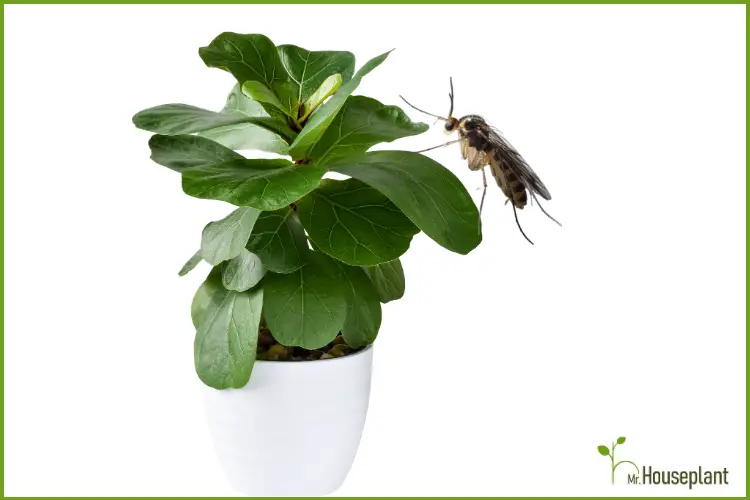
Fiddle Leaf Fig pests can be a significant cause for concern for Fiddle Leaf Fig owners. As a responsible plant parent, it’s essential to be educated on pests that can affect your dear plant. This blog post answers all your questions, from recognizing the warning signs of the most common pests to treatment and prevention.
What Types Of Pests Can Attack My Fiddle Leaf Fig?
The most common pests that can attack Fiddle Leaf Figs are:
- Spider mites
- Fungus gnats
- Mealybugs
- Scales
- Thrips
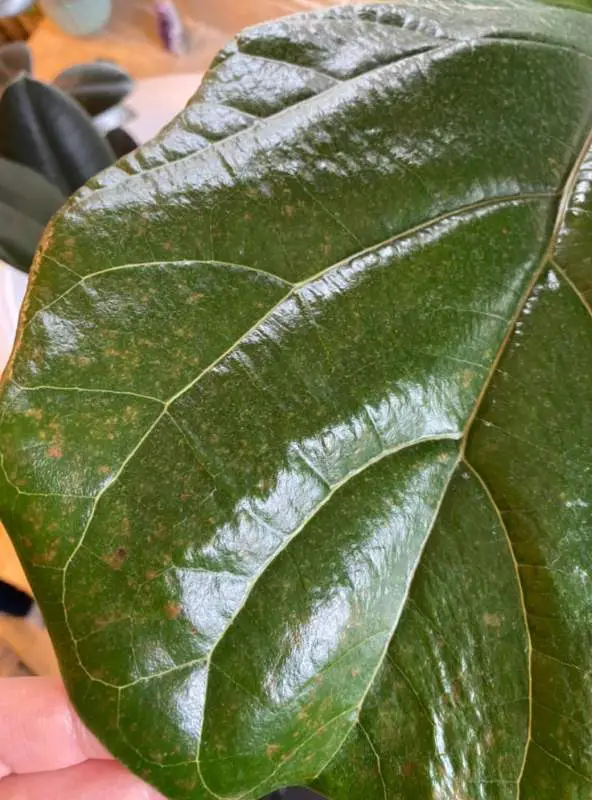
Spider mites damage on Fiddle Leaf Fig leaf
The first important step when dealing with pests in Fiddle Leaf Figs is to correctly identify the insects that are wreaking havoc. Recognizing early signs is vital to stop the pests from spreading to other plants and to save your beloved Fiddle Leaf Fig tree.
How Do I Determine Which Pests Are Attacking My Fiddle Leaf Fig?
To determine which pests are attacking your Fiddle Leaf Fig you will need to observe your plant carefully, with the aid of microscope or macro lens for best results. Some insects, such as scales and mealy bugs, are easy to identify, since they have a characteristic appearance.
However, it can be difficult to distinguish between spider mites, aphids, and thrips in early stages of infestation, since they cause similar type of damage to the leaves. The best way to recognize what insect is to blame for the infestation, is to use a magnifying glass, a microscope or a macro lens and look carefully at the insects.
In later stages of infestation, spider mites can be easily distinguished from other houseplant pests since they produce webs, which become more noticeable in severe infestations. Spider mites have an oval body and eight legs. If you notice any thin silky strands take a close look at the plant’s leaves. If you also notice tiny clustered dots that move, you’re most likely dealing with spider mite insects.
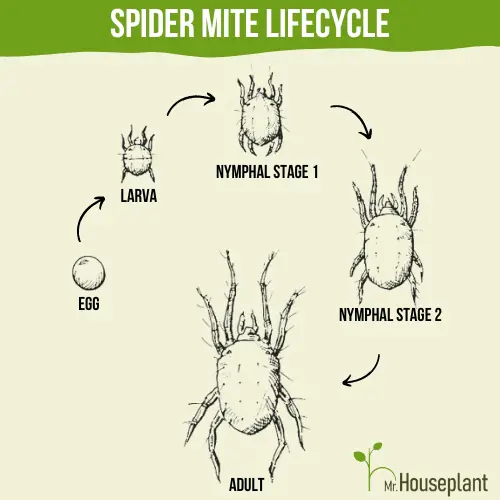
Spider mite lifecycle includes egg, larva, nymphal stages and adult. Photo from University of California
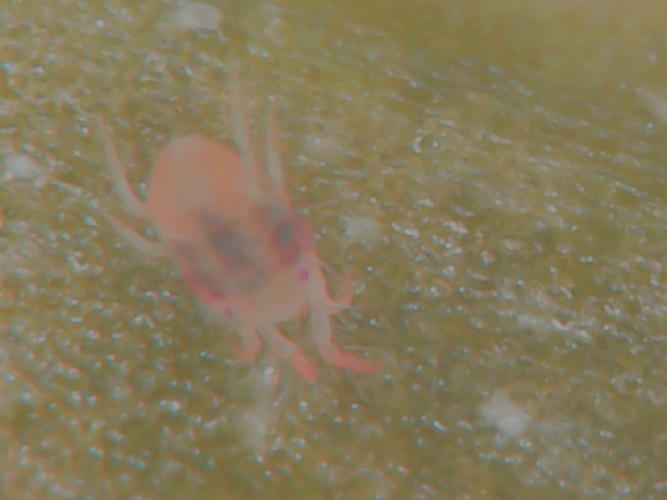
Spider mites cause damage by piercing plant cells and sucking the plant sap
Fungus gnats are small dark, flying insects that usually run across the soil, and lay eggs in the top two inches of the soil. Luckily, they don’t cause a lot of damage, but they’re nonetheless a nuisance.

Fungus gnat lifecycle includes eggs, larva, pupa and adult. Photo from Cornell university/K. Bennett
Mealybugs are small soft-bodied white insects that leave powdery traces on the foliage of Fiddle Leaf Figs. They feed on the plant sap and secrete honeydew, a wet-looking sticky substance. When laying eggs, female mealybugs produce cotton-like material. The cottony substance will be a telltale sign of mealybug infestation.
Scale insects are oval-shaped, with colors ranging from light tan to dark brown. They are tricky to spot since they blend with the color of the Fiddle Leaf Figs. Scale insects can usually be found on the foliage, especially along leaf veins, on the petioles, or on the underside the leaves. Like mealy bugs, scale insects also excrete honeydew. Serious scale insect problems can lead to wilting and leaf shedding.
Thrips are elongated, slender insects with wings. Their color varies from translucent white and yellow to dark brown and black. These pests suck the sap of Fiddle Leaf Figs. The infested leaves become deformed or curled, with silvery scars in the areas where feeding has occurred.
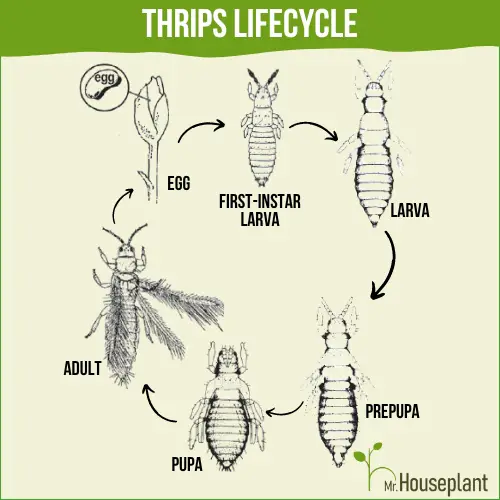
Thrips lifecycle includes egg, first-instar larva, larva, prepupa, pupa and adult. Photo from University of California
How Do I Get Rid Of Spider Mites On My Fiddle Leaf Fig?
To get rid of spider mites on your Fiddle Leaf Fig use one of the following methods:
- Strong stream of water
- Neem oil solution (5 drops of neem oil and 5 drops of dish soap in 16oz of water)
- Insecticidal soap or horticultural oil
- Miticide
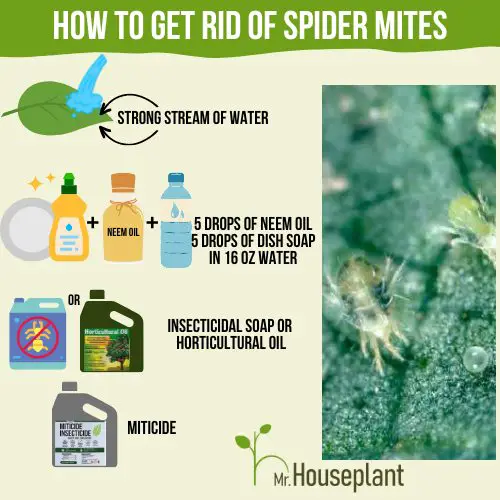
Choose any of these four options to get rid of Spider Mites
If you’re dealing with a minor infestation, you can treat spider mites with plain water. Spray down your Fiddle Leaf Fig with a strong stream of water to dislodge spider mites. Don’t forget to spray both the top side and the underside of the leaves to remove eggs and adult insects that are stuck to the foliage. Since a new generation of spider mites can be produced in as short as one week, you will have to repeat the process 2 to 3 times a week, for several weeks, until there are no more spider mites.
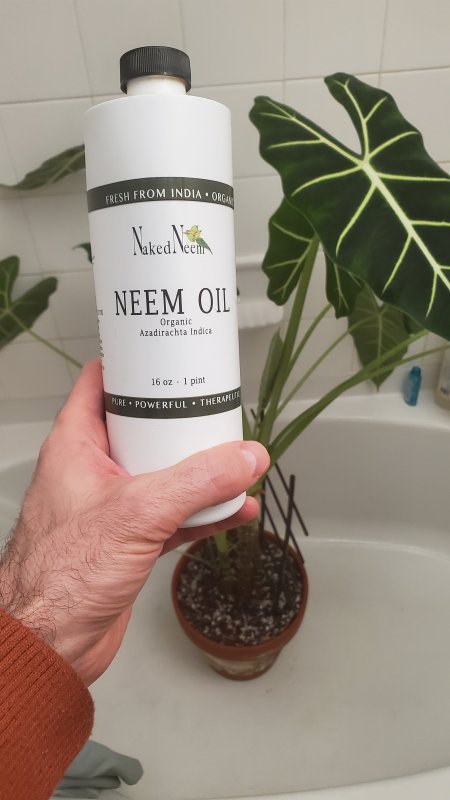
Neem oil is an effective organic remedy for pest infestations
Neem oil is a great natural remedy for pests. If you’re looking to treat spider mites with an eco-friendly solution, opt for neem oil. It has pesticidal properties that make it quite efficient against spider mites. Neem oil should be mixed with water and a few drops of dish soap for optimal results.
Insecticidal soaps are a good option for more severe insect infestations. They are safe and effective choices for pest control. You can make your own insecticidal soap, but if you’re inexperienced you could damage your Fiddle Leaf Fig, so it’s best to buy a commercial insecticidal soap. Always read the label on the packaging carefully to avoid injuring your plant. Mix the soap concentrate in a spray bottle, according to the instructions.
Make sure to spray your Fiddle Leaf Fig thoroughly, especially the undersides of the leaves, since spider mites love to settle there. You might have to repeat the process every 4 to 7 days, depending on the directions on the label.
How To Get Rid Of Fungus Gnats In Fiddle Leaf Fig?
To get rid of fungus gnats in your Fiddle Leaf Fig pick one of these methods:
- Mosquito Bits and yellow sticky traps
- Hydrogen peroxide soil drench
- Systemic insecticide
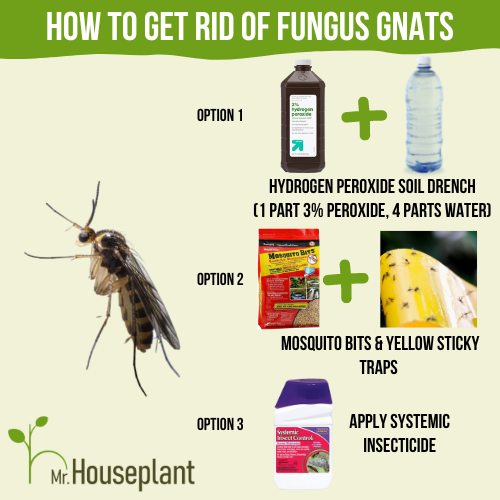
Each method is very effective against fungus gnats
Mosquito bits are pellets that are made of corn cob. They contain the bacteria Bacillus Thurigiensis israelensis (BTI), which is not toxic for humans and pets, but it’s effective against gnats. To treat Fiddle Leaf Figs, put Mosquito Bits in water with which you water your plant, and leave them in for half an hour. This will give BTI enough time to separate from the corn cob and be released into the water.
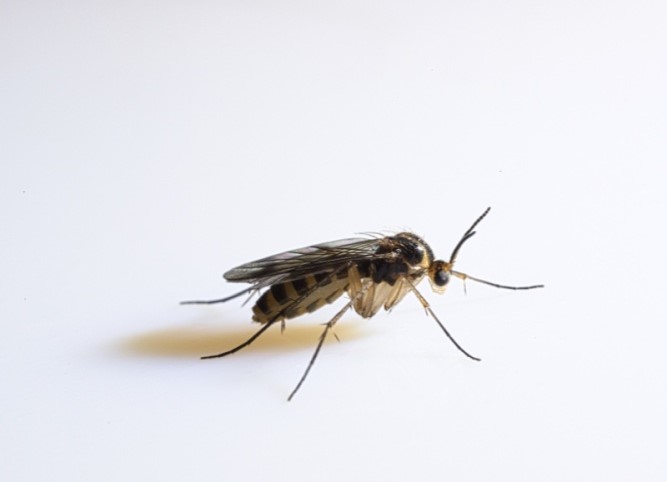
Fungus gnat is a small winged insect that can usually be found in the top two inches of the soil
You can start with 1 tablespoon of Mosquito Bits per gallon of water, and increase the dosage based on results. Stir the water before using it to ensure BTI is spread evenly. Water the full surface of the soil, to make sure all fungus gnats will be eradicated. Gnats larvae will eat BTI and die. You will have to be patient and repeat the process when using this method, as it may take 2-3 weeks to kill all larvae since adult insects will continue to lay eggs in the meantime.
For best results, you can combine yellow sticky traps with Mosquito Bits, since traps kill adult insects and Mosquito Bits kill larvae. This will speed up the process and you won’t have to wait 2-3 weeks to kill all larvae. Gnats are attracted to yellow color and they fly towards the yellow sticky traps, get caught, and die.
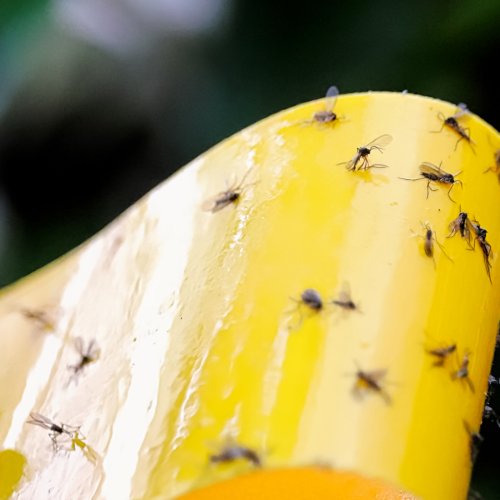
Fungus gnats caught on a sticky trap
Another quick and easy method is to use hydrogen peroxide. Mix one part 3% hydrogen peroxide with four parts water. Pour into the soil until it starts draining at the bottom and fungus gnat larvae will die immediately. Hydrogen peroxide is also used to treat certain fungal root diseases, so if used in the right concentration, it’s safe.
Another way to get rid of fungus gnats is by using a systemic insecticide. Mix it with water and use for watering your plants. As the water gets in contact with fungus gnat larvae, it will kill them. I use 1 teaspoon of systemic insecticide per ½ or ¼ gallon of water and then water the plants the same way I would normally water them. Be careful! Overdosing with systemic insecticide can easily kill your plant. Always test on one plant first, wait for a few days, and if the plant is fine, use it on other plants.
How To Get Rid Of Mealybugs On Fiddle Leaf Fig?
These are the most effective ways to get rid of mealybugs on Fiddle Leaf Fig:
- Manual removal with a cotton swab dipped in alcohol
- insecticidal soap or horticultural oil
- Neem oil solution (5 drops of neem oil and 5 drops of dish soap in 16oz of water)
- Rubbing alcohol solution (1 part alcohol, 7 parts water)
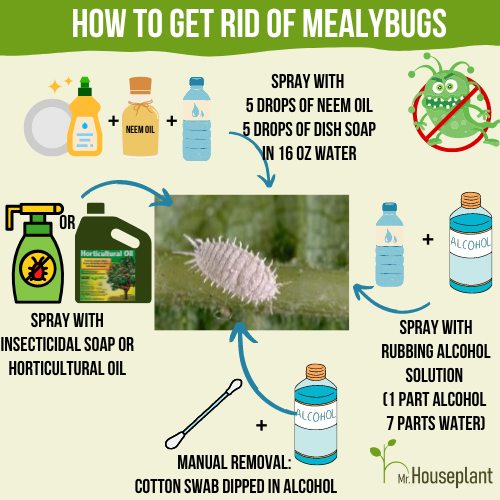
If your plant is infected with mealybugs, these four methods will help in your fight against them
If your Fiddle Leaf Fig is suffering from a minor mealybug issue, you can first try to remove the mealybugs by hand, by using a cotton swab dipped in rubbing alcohol. You will likely have to repeat hand-removal multiple times to destroy all the mealybugs, as they like to hide in plant crevices.
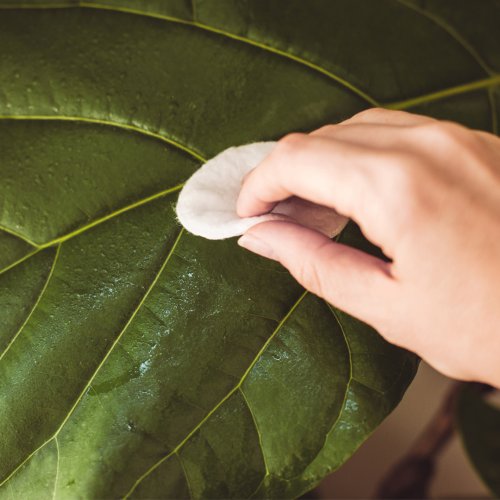
Treating mealybug infestation by wiping Fiddle Leaf Fig’s leaves with a mixture of rubbing alcohol and water
The best way to get rid of mealybugs is to spray the plant with a rubbing alcohol solution (1 part alcohol, 7 parts water). This solution can penetrate mealubugs’ protective wax coating. Spray one leaf first and wait for 48 hours. If there is no damage to the leaf, you can spray the whole plant. Make sure to spray the topside and underside of all leaves and all crevices where mealybugs can hide.
Another way to get rid of mealybugs is to spray the plant with insecticidal soap or horticultural oil. Spray thoroughly topside and underside of all leaves. You might need to repeat this method because mealybugs have a protective wax coating which soaps and oils do not always penetrate.
Another solution to get rid of mealybugs is to spray the plant with a neem oil solution. Mix 5 drops of 100% pure neem oil and 5 drops of dish soap in 16oz of water in a spray bottle. Shake well and spray the plant thoroughly. Avoid exposing the plant to direct sun and grow lights for a few hours, as direct sunlight exposure or grow light exposure after neem oil treatment can cause leaf damage.
How To Get Rid Of Scales On Fiddle Leaf Fig?
You can use the following methods to get rid of scales on Fiddle Leaf Fig:
- Physically remove them
- Insecticidal soap or horticultural oil
- Dishwashing detergent and water
If you’re dealing with a minor infestation, you can remove the insects by picking them off the leaves. However, this is a tedious process and it isn’t recommended for more severe infestations, because it’s time-consuming and not so effective on a larger scale.
To use insecticidal soap or horticultural oil for scale control, spray the plant thoroughly, topside and underside of all leaves.
If you would like to avoid using insecticidal soaps, you can treat scales with a mild soap diluted in water. Use 1 tbsp of soap per one quart of water. Put the solution in a spray bottle, shake well and thoroughly spray your Fiddle Leaf Fig. You may have to repeat the application process every 4 to 7 days until the pest issue is under control.
How To Get Rid Of Thrips On Fiddle Leaf Fig?
The best way to get rid of thrips on Fiddle Leaf Fig is to use insecticides. Unfortunately, thrips are notoriously difficult to treat, and milder methods don’t work that well. Contact insecticides, such as azadirachtin and pyrethrins, that have low toxicity to people and pets and that don’t leave persistent residue, are a good choice.
For the contact insecticide to work, you need to apply it thoroughly to cover all the parts of your Fiddle Leaf Fig where thrips are present. If you use a contact insecticide, unless otherwise instructed by the product label, you should repeat the application as long as thrips are present.
You can also use systemic insecticides, for a relatively rapid thrip control. Unlike contact insecticides that are sprayed on the plants, systemic insecticides are absorbed by the plant through watering and transported through roots, stems, and leaves. Always read the label carefully when using systemic insecticides, as overapplication can kill your Fiddle Leaf Fig.
How To Keep Bugs Away From Fiddle Leaf Fig?
To keep bugs away from Fiddle Leaf Figs you must ensure that your plant is strong and healthy, and not stressed. You should provide your plant with the best possible conditions for growth. If a plant is stressed, it is more susceptible to pests and diseases. Fiddle Leaf Figs, like other indoor plants, need proper light, proper watering practices, and proper potting soil management. Proper soil management consists of using a high-quality well-draining porous potting mix and repotting your plant at least once a year to provide it with fresh, non-compacted soil which contains all the important nutrients.
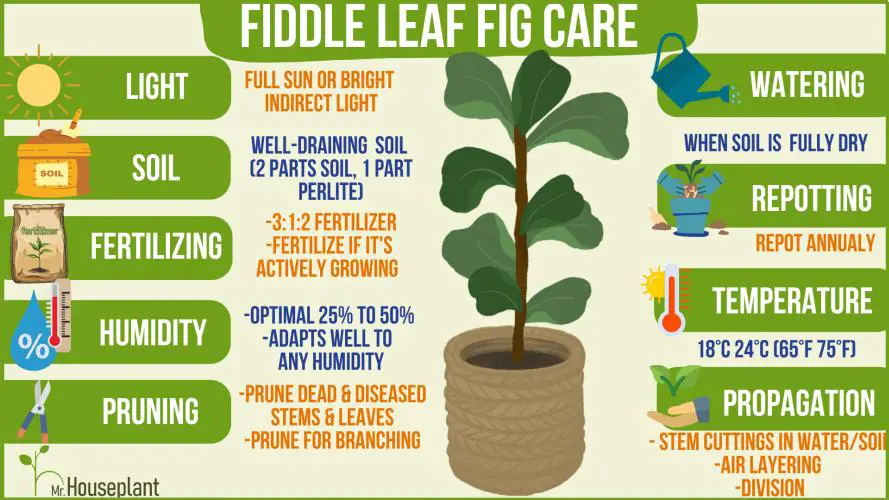
Light, watering, soil, repotting, fertilizing, temperature, humidity, propagation, and pruning are equally important in the Fiddle Leaf Fig care process
How Do You Treat Fiddle Leaf Fig With Neem Oil?
To treat Fiddle Leaf Figs with neem oil you should mix it with water and add a couple of drops of dish soap. Why is it important to add soap to the neem and water mixture? Because oil and water don’t mix well, and they will separate if you let them settle.
Adding a few drops of dish soap to the mixture causes a process called emulsification. In this process, the liquids mix well together which makes the treatment more effective. You can mix just water and neem oil, but adding dish soap will improve the outcome of the treatment. After treatment, Fiddle Leaf Figs should be moved away from direct sun for the next 24 hours to avoid burns to foliage.
Yours Truly,


Related Posts
Sansevieria Black Gold (Snake Plant Care GUIDE!)
Spathiphyllum Sensation (FULLY Explained!)
Alocasia Stingray Care